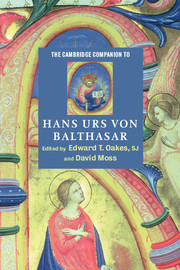Book contents
- Frontmatter
- 1 Introduction
- Part I Theological topics
- 2 Revelation
- 3 Christology
- 4 Balthasar and the Trinity
- 5 For the life of the world: Hans Urs von Balthasar on the Church as Eucharist
- 6 Balthasar and the figure of Mary
- 7 The saints
- 8 One sex or two? Balthasar’s theology of the sexes
- 9 Eschatology
- Part II The trilogy
- Part III Disciplines
- Part IV Contemporary encounters
- Select bibliography
- Index
8 - One sex or two? Balthasar’s theology of the sexes
from Part I - Theological topics
Published online by Cambridge University Press: 28 May 2006
- Frontmatter
- 1 Introduction
- Part I Theological topics
- 2 Revelation
- 3 Christology
- 4 Balthasar and the Trinity
- 5 For the life of the world: Hans Urs von Balthasar on the Church as Eucharist
- 6 Balthasar and the figure of Mary
- 7 The saints
- 8 One sex or two? Balthasar’s theology of the sexes
- 9 Eschatology
- Part II The trilogy
- Part III Disciplines
- Part IV Contemporary encounters
- Select bibliography
- Index
Summary
EXPOSITION
For Hans Urs von Balthasar a fundamental truth about being human is the limit imposed on human nature by the polarity of sexual difference: one is born either male or female (TD3, 283). To be human is to be not simply one but one of two, a dyad, with one sex opposite to or over against the 'other'. 'Man only exists in the opposition of the sexes, in the dependence of both forms of humanity, the one on the other.' There has never been a universal, sexually neutral person, no original 'androgynous primal being' or 'sexless first man' (TD3, 290):
The male body is male throughout, right down to each cell of which it consists, and the female body is utterly female; and this is also true of their whole empirical experience and ego-consciousness. At the same time both share an identical human nature, but at no point does it protrude, neutrally, beyond the sexual difference, as if to provide neutral ground for mutual understanding. Here there is no universale ante rem . . . The human being, in the completed creation, is a 'dual unity', two distinct but inseparable realities, each fulfilling the other, and both ordained to an ultimate unity that we cannot as yet envisage. (TD2, 364–5; emphasis added)
- Type
- Chapter
- Information
- The Cambridge Companion to Hans Urs von Balthasar , pp. 93 - 112Publisher: Cambridge University PressPrint publication year: 2004
- 13
- Cited by



